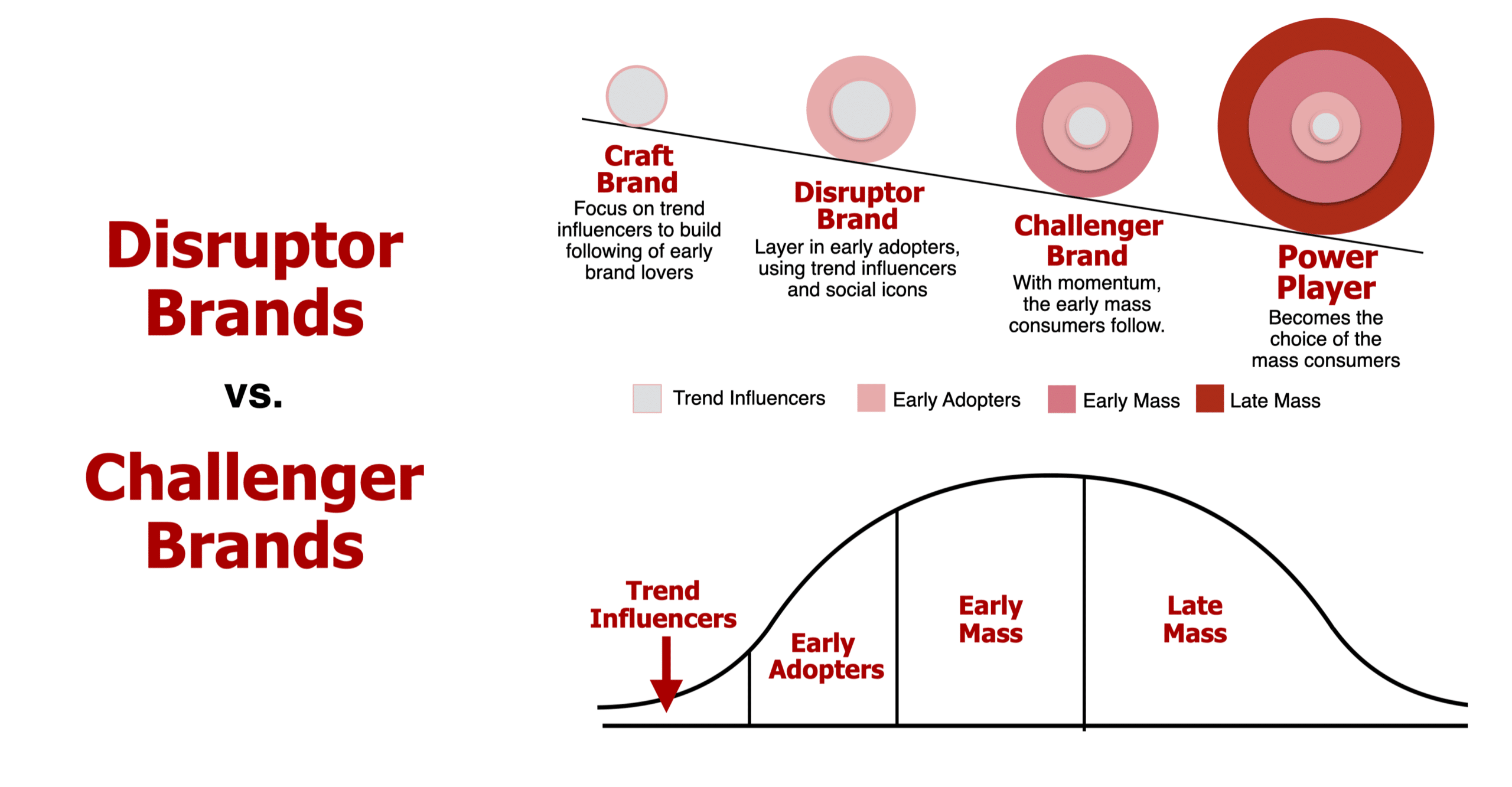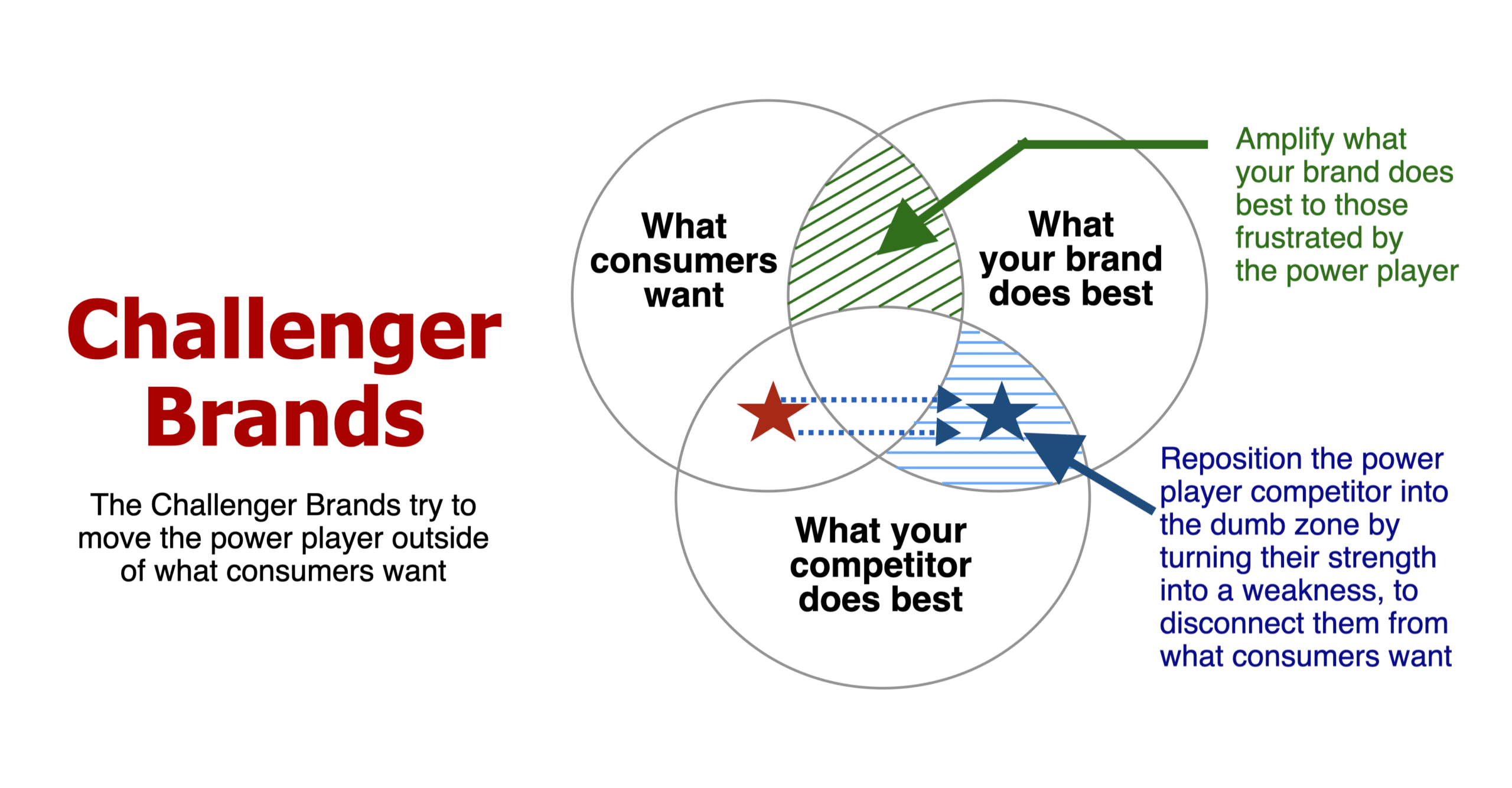Every day, I see people mess up by randomly using the key marketing words disruptor brand and challenger brand. I guess these words seem to convey an attitude that makes people think they are buzzwords. But when it comes to competitive strategy, they are quite different. The common link is they both take on an aggressive war games approach.
To be a disruptor brand, you must take on an entire category by appearing so new and different. Once consumers see what they offer, all the current players seem outside of what consumers now want. The disruptor brand is a blue ocean strategy, so different, they appear to be alone on an island, far away from any competitors. Current competitors have two options to the disruptor; ignore or attack back. The problem is they need to be prepared to attack back. Any attempt to oppress the disruptor brand brings attention to the disruptor and fuels their cause.
To illustrate, click on our competitive strategy model for challenger brands and disruptor brands.
On the other hand, the challenger brand takes on the leading power player brand and shifts the perception of the leader, and set themselves up as the winner of this war. A challenger brand is a red ocean strategy, so close to the category leader, they are defiant in their attack. The category leader has two choices to fight the challenger brand; attack back or be killed. This is the reason I always say that a challenger brand should reposition the leader’s strength into a weakness, as it handcuffs the leader’s ability for the brand to attack back.
Challenger vs Disruptor Brands - Table of Contents
Brand strategy
Brands must evolve their strategy as they move from the craft brand to the power player brand
Many brands start in someone’s garage or over a kitchen table at midnight. Start-ups should deploy a craft brand strategy. To stand out, you must be utterly different to a core group of trend influencers who are frustrated with the major competitors.
As your brand grows, you can transition to a disruptor brand strategy. Utilize your core audience of trend influencers to gain a core base of early adopters. While a craft brand attracts the attention of trend influencers, the disruptor brand must dial up their aggressive stance and call out the major brands.
As your brand continues to grow, you can use your increased resources and power to take on a challenger brand strategy against the leader. You can use the influence of the trend influencers and early adopters to attract the early mass audience.
The most successful brands end up a conglomerate
At the power player stage, the strategy shifts to maintaining your leadership position. You should take on a defensive strategy, to attack in response to any player who threatens your brand. While the trend influencers and early adopters played a considerable role in making the brand a household name, you have to be comfortable that your earliest brand fans will eventually leave your brand and look for what is next.
Competitive strategy
How to find your space in the market to win
To find the competitive space in which your brand can win, I introduce a Venn diagram of competitive situations that we will use throughout this discussion.
To illustrate, click on our competitive strategy model for challenger brands and disruptor brands.
You will see three circles. To start, look at the first circle that comprises everything your consumer wants or needs. Next, layer in the second circle that includes everything your brand does best, including consumer benefits, product features or proven claims. Finally, the third circle lists what your competitor does best.
Your brand’s winning zone (in green), is the space that matches up “What consumers want” with “What your brand does best.” This space provides you a distinct positioning you can own and defend from attack. You must be able to satisfy the consumer needs better than any other competitor can.
Your brand will not survive by trying to compete in the losing zone (in red), which is the space that matches the consumer needs with “What your competitor does best.” When you play in this space, your competitor will beat you every time.
Competing in a mature market
As markets mature, competitors copy each other. It has become harder to be better with a definitive product win. Many brands have to play in the risky zone (in grey), which is the space where you and your competitor both meet the consumer’s needs in a relative tie.
There are four ways you can win the risky zone:
- First, use your brand’s power in the market to squeeze out smaller, weaker brands.
- Second, be the first to capture that space to earn a reputation you can defend
- Next, you can win with innovation and creativity to make your brand seem unique
- Finally, you can build a deeper emotional connection to make your brand seem different
The dumb zone
Sadly, I always have to mention the dumb zone (in blue) where two competitors “battle it out” in the space consumers do not care. One competitor says, “We are faster,” and the other brand says, “We are just as fast.” No one bothered to ask the consumer if they care about speed. Essentially, both brands are dumb.
To illustrate, click on our competitive strategy model for challenger brands and disruptor brands.
Challenger brands
Challenger brands must change the playing field by amplifying what your brand does best while simultaneously repositioning the power player brand you want to take down.
While your first instinct would be to attack the power player’s weakness, the smarter move is to reposition one of the power player’s well-known strengths into a perceived weakness. This strategy helps move the power player brand outside of what consumers want.
To illustrate, click on our competitive strategy model for challenger brands and disruptor brands.
Focus your attack
When you attack a power player brand, be ready for the leader’s potential defensive moves and anticipate a response with full force, as the power player brand has more significant resources than you. You also need to be highly confident that your attack will make a positive impact before you begin to enter into a war. The worst situation is to start a war you cannot win, as it will drain your brand’s limited resources, only to end up with the same market share after the war.
Since the power player leader tries to be everything to everyone, you can narrow your attack to slice off those consumers who are frustrated with the leading brand. Tap into their frustration to help kickstart a migration of consumers away from the leader. If you can gain these lost consumers, you can quickly change share positions.
Example of challenger brands
One of the best competitive strategy examples of a challenger brand that made significant gains is the Pepsi Challenge from the 1970s. It was a direct offensive attack on Coke. In blind taste tests, Pepsi was the preferred brand. Pepsi is a much sweeter taste, so in a quick hit, it was the chosen brand. Coke is an acquired and memorable taste. The blind taste test took away the Coke brand name and the emotional feelings of that brand.
At the same time, Pepsi amplified its strength as the “new generation” and positioned the brand as the solution to consumers ready to reject the “old taste” of Coke. This approach was so powerful it was even a contributing factor to the launch of a sweeter “New Coke.”
To illustrate, click on our competitive strategy model for challenger brands and disruptor brands.
Marketers see Beloved Brands playbook as a go-to resource, as they keep it within arm’s reach for any new project. We are thrilled to see that it has received a 5-star rating from nearly 90% of Amazon reviewers.
Disruptor brands
Disruptor brands move into a blue ocean space, all by themselves. They use a new product, distribution channel, target market or price point. And, they are so different they appear to be the only brand that can satisfy the consumer’s changing needs.
To illustrate, click on our competitive strategy model for challenger brands and disruptor brands.
When successful, the disruptor brand repositions the major players, making them appear unattached to consumers.
While everyone wants a game-changer, it is a high-risk, high-reward competitive situation. The trick is you have to be “so different” to catch the consumer’s attention and mindshare. Being profoundly different increases the risk you may fail. Also, your success may invite other entrants to follow. At that point, you become the new power player of the new segment. Essentially, you have to continue attacking the major players while defending against new entrants who attack your brand.
Examples of disruptor brands
Uber, Netflix, and Airbnb are contemporary brands that effectively use modern technology to create such a unique offering. They cast major category-leading brands or entire industries as outdated and outside what consumers want.
Uber disrupted the taxi market, Netflix is revolutionizing the way we watch TV, and Airbnb has had a dramatic impact on hotels. These brands have a smarter ordering system, better service levels, and significantly lower prices. Indeed, it leaves the previous leaders struggling to fight back.
To illustrate, click on our competitive strategy model for challenger brands and disruptor brands.
Strategic key issues video lesson
Watch how to find the key issues on your brand that you can use in your marketing plan. If strategic thinkers see the right questions first, then you need to find the best possible questions before you can think about solutions.
To view, use the ▶️ controls to play or volume buttons














